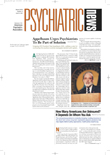Mike, an 8-year-old boy with significant cognitive limitations and a history of witnessing domestic violence, is an inpatient on a child psychiatric unit. He walks up to a member of the milieu staff and begins pulling on her arm. The staff member gently asks him to please stop, as this is hurting her. Instead of stopping, he gets more and more agitated, pulling at her more and more forcefully, ignoring verbal redirection. What should the next intervention be?
I recently had the privilege of spending four months on the Child Assessment Unit (CAU) at Cambridge Hospital, a 13-bed unit for children ages 2 to 13, which has managed to eliminate the use of physical, chemical, and mechanical restraints, as well as locked-door seclusion. My time there made me rethink many of my assumptions about the purpose of inpatient care, as well as behavioral interventions. I left convinced that this unit is at the vanguard of a revolution in how we treat agitated and aggressive patients in child psychiatry.
I had heard a great deal about the changes taking place on this unit prior to starting there. As an adult psychiatry resident at Cambridge Hospital, I heard the child psychiatry fellows talking about the transition to a new model of care with great trepidation and concern. How could you keep staff and kids safe if you couldn’t restrain someone? How could kids learn to behave properly if they never got consequences for bad behavior? How could you run a unit without the ultimate in limit setting (restraints) as an option? Isn’t the purpose of an inpatient unit safety and containment? As a former day care teacher, I believed in the importance of minimal but consistent limit setting.
The answer to these questions starts with rethinking the core mission of an inpatient unit. When the leaders of the CAU started to think about these changes, their first step was to change the mission from safety and containment to nurturance and teaching. On a practical level, this meant the end of formal visiting hours. Parents can (and do) come on to the unit any time of day or night, and may even spend the night with their children, if they desire. They also allow more physical contact between staff and patients. Staff not only give kids high fives and return hugs, they even sometimes initiate them. Walking through the CAU, one immediately notices this difference. Instead of feeling like a structured, contained, even cold environment, it feels warm, friendly, and relaxed.
But the most dramatic changes that were made had to do with the behavior plan—it was eliminated. Instead of an elaborate points system, in which patients had to earn privileges by good behavior, it was assumed that kids would be allowed off the unit once they had been there 24 hours, unless some very good reason otherwise existed. Perhaps most remarkably, there was no set list of consequences for certain behaviors. Every situation was judged independently, at the moment, and interventions were tailored to a particular child at a particular moment.
The unit adopted Ross Greene’s concept of Collaborative Problem Solving. Greatly simplified, this program focused on avoiding strict limit setting in favor of compromise and negotiation to help kids understand the reasons for their behavior and practice better ways to get what they need. This has required a far more detailed understanding of each child, what drives his or her behavior, and what helps. Instead of just looking at what a kid is doing, one must understand why. Such an approach forces all the clinicians (from milieu staff to attendings) to formulate cases deeply and to tailor interventions accordingly.
Another staff member approaches and comments that she saw Mike on the phone asking his mother to pick him up at the hospital. It appeared his mother had hung up on him. The two staff members start to talk to Mike about other things he could do if he’s feeling upset. Many suggestions are offered, and Mike starts to relax his grip. Eventually Mike agrees that getting out a stuffed animal to hold on to might help. He lets go, and they go to the closet together and pick one out.
This is just one example of the types of interactions I witnessed daily on the CAU during my four months there. It is, however, an excellent example. On a unit more focused on behaviors than the reasons behind them, this could easily have escalated into a restraint. Instead, staff used their knowledge of this child’s limitations, his history, and recent events to tailor their intervention in a way that not only de-escalated the situation, but also more directly attended to his needs. I hope that my work as a child psychiatrist will be similarly nurturing, responsive, and effective. ▪

